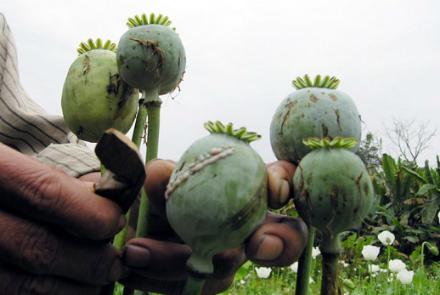Afghanistan set new records for opium production in 2016 despite an $8.5 billion USD counternarcotics campaign investment by U.S agencies, the Special Inspector General for Afghanistan Reconstruction's (SIGAR) stated in its latest quarterly report to Congress.
The report said that opium production increased 43 percent in 2016, while poppy eradication hit a 10-year low and was "nearly imperceptible."
It said that the United Nations Office of Drugs and Crime (UNODC) conduct an annual survey with financial contributions from the United States and other donors.
UNODC estimated that the potential gross value of opiates was $1.56 billion USD - or the equivalent of about 7.4 percent of Afghanistan’s Gross Domestic Product (GDP) - in 2015.
“The latest 2016 UNODC country survey estimates opium cultivation increased 10 percent, to 201,000 hectares, from the previous year,” the report said adding that “the southern region, which includes Helmand, Kandahar, Uruzgan, Zabul, and Daykundi provinces, accounted for 59 percent of total cultivation. Helmand remained the country’s largest poppy-cultivating province, followed by Badghis and Kandahar.”
"Deteriorating security conditions, a lack of political will and the Afghan Ministry of Counter Narcotics' ineffective management all contributed to the paltry eradication results in 2016," the report said.
Poppy "cultivation remained near historically high levels compared with the past several decades."
Meanwhile, Afghanistan's "narcotics industry - coupled with rampant corruption and fraud - is a major source of illicit revenue," the report said.
The "opium trade provides about 60 percent of the Taliban's funding."
“Since the collapse of the Taliban government, the opium trade has grown significantly and enabled the funding of insurgency operations. Taliban commanders collect extortion fees for running heroin refineries, growing poppy, and other smuggling schemes,” according to the report.
“Powerful drug networks, mainly run by close-knit families and tribes, bankroll the insurgency and launder money. There have been media reports and allegations of corrupt government officials participating in the drug trade,” it said.
The Taliban is an Islamic extremist group that ruled Afghanistan until the U.S military intervention following the Sept. 11, 2001, al Qaeda attack in New York and Washington, D.C. that killed more than 3,000 people. The Taliban allowed al Qaeda to use Afghanistan as its training base for attacks against the U.S. and other western nations.
"Traffickers provide weapons, funding, and material support to the insurgency in exchange for protection, while insurgent leaders traffic drugs to finance their operations," the report said.
Afghanistan "remains the world's largest opium producer and exporter - producing an estimated 80 percent of the world's heroin.
John Sopko, head of SIGAR, recommended that President Donald Trump establish "a U.S counternarcotics strategy, now years overdue, to reduce the illicit commerce that provides the Taliban with the bulk of their revenue."


